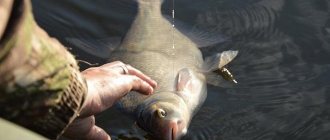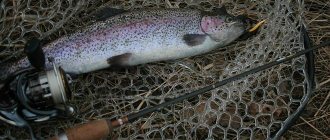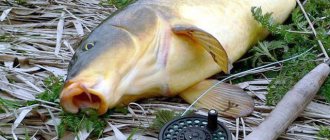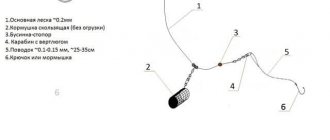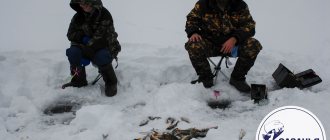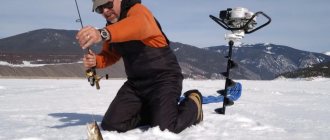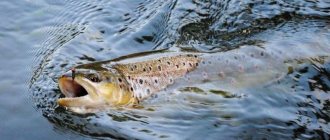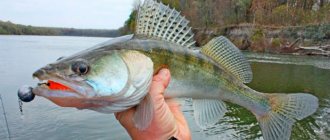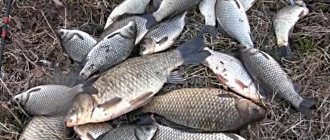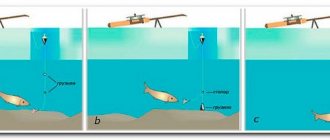Yuri 03.11.2020 417
Fishing is always unpredictable and also brings a number of surprises. It often happens that in sunny, warm weather the fish completely refuse to bite. And vice versa, it happens that in windy, rainy weather the most effective bites occur. Isn't this surprising? Therefore, I will tell you in detail how the weather affects winter fishing, when it is worth going on a quiet hunt, and when it is better not to do this.
Experienced fishermen know how weather conditions affect fishing. In addition, almost every hunter has his own specific signs for each season. When going fishing, many fishermen monitor weather changes.
Fishing in January
In January, all underwater vegetation that has fallen to the bottom begins to actively decompose, oxidize and rot. This process has a detrimental effect on the oxygen content in the water, the lack of which affects the behavior of the fish. Therefore, in order not to be left without a catch, you should not expect a bite in such places. It is better to look for fish in areas with a clean bottom, preferably muddy or sandy.
The most productive fishing will be in reservoirs with a current, where the water is naturally enriched with oxygen due to the constant mixing of water masses. In January, the fish roll into wintering pits, hang around areas rich in natural food, stand near coastal reeds, at depth changes and other promising places.
The most successful bite will be in the following cases:
- during a prolonged thaw that occurred immediately after frost;
- on quiet, sunny and windless days at a temperature of no more than 10 degrees.
You should not hope for a catch during:
- sudden changes in pressure and temperature;
- any precipitation;
- strong wind, especially from the north.
Optimal conditions for fishing in winter
Perch is the most active fish in winter, and the bulk of the entire catch will come from it. The most active perch bite occurs under the following conditions:
- frosty weather;
- stable atmospheric pressure;
- slight precipitation.
- Important! The best time is a thaw after a long frosty weather. In such conditions, you can catch a predator all day long.
When there has been heavy snowfall outside for several days, you shouldn’t count on a serious catch.
What to fish for in January
Since January is considered a period of deep winter, fishing at this time with rough gear is strictly not recommended. The tackle should be as miniature as possible - thin as a gossamer, fishing line up to 0.1 mm thick, small jigs, spinners and other artificial baits, responsive nods, tiny floats, etc. Interesting: About catching winter bream
A float fishing rod can have a fishing line with a diameter of up to 0.15 mm, but in this case, thin leashes are required. The float must be hidden under water during fishing so as not to freeze to the ice film formed on the surface of the hole. The hooks are small and very thin, so as not to damage baits of animal origin - bloodworms, maggots and others. Features of winter bream fishing with a reelless bait
Jig fishers will have to temporarily hide large baits in the back compartment of their fishing box, since in January they can only count on a bite when using very tiny jigs. The game with bait is sluggish, without sudden movements. If you have to fish at great depths, at which light jigs simply do not work, then it is better to switch to baits made from heavy types of metals, for example, silver alloys and the like. When fishing in the current, it is advisable to place a sinker on the tip of the fishing line, and tie the jigs themselves higher on thin leashes. Read also: Prey fishing by helicopter
In January, lures will have the hardest time, as the fish lose activity and are not particularly eager to chase moving bait. In this case, it is best to use:
- small gliding spinners that can provoke a predator to strike;
- mini balancers;
- silicone baits used for microjigging.
The best way to catch a predator in January is to fish with winter baits. No matter how lethargic and passive the fish may be, it is unlikely that it will refuse the appetizing live bait that nimbly scurries in front of its nose. The only condition when catching a predator using girders is the use of small live bait, preferably caught from the same reservoir, since it will not even look at a large palm-sized crucian carp.
What happens under the ice in the middle of winter
In cold water, fish become less active than in summer in all cases without exception. This is easily explained by some balance between expending energy and finding suitable food. While in this state, the fish hardly move. Very affordable, often live food can now force them to move.
During the dry winter period, an unwritten rule applies: the more passive the fish becomes, the more the angler has to move. As a rule, the deterioration of biting occurs gradually. Only when the lack of bite continues day after day, despite the efforts of the fisherman, can it be said that a dead winter has actually set in on a given body of water.
Small, remote and low-flow ponds and lakes are the first to be hit. In conditions of weak water supply, and therefore oxygen, the bite of underwater inhabitants may end in just one or two weeks. Of course, the probability of catching fish remains even then, but only at certain hours, in the right place. Knowledge of a reservoir becomes a serious assistant when fishing in difficult conditions, but alas, you will have to forget about a good bite until the snow melts profusely.
I see the point in fishing in these reservoirs in winter only in two cases:
- Tired of languishing at home and want to breathe some fresh air;
- I really want to go fishing, but there is no way to change the reservoir to a larger and flowing one.
We recommend reading: Catching pike perch with amphipods
Perch fishing in January
The perch bite in January is significantly influenced by the presence of oxygen in the water. The more of it there is, the more actively the striped robber is caught. You can try looking for perch in the following places:
- near coastal dumps;
- on the riverbed;
- among snags and flooded bushes and trees;
- on a hard bottom;
- next to the small fish parking lot.
Small perch will be caught close to the shoreline in thickets of coastal plants - reeds, reeds, cattails.

When fishing for perch in January, small jigs are used. When fishing with a regular jig, bloodworms, maggots, burdock moth larvae, etc. are used as bait. It is worth paying attention to the fact that even when fishing with a reelless bait, it is better to attach a perch eye or a rolled-up bloodworm to the jig hook.
The perch is cast on vertical spinners with a small tee tied at the attachment point of the fishing line and bait, on which it is hooked, and the lower single hook, tightly soldered into the body of the bait, acts as a sort of anchor that lifts mud from the bottom. You can also try catching the striped predator using small brightly colored balancers from well-known manufacturers. This is interesting: Effective tackle "Balda";
Equipment Features
Winter fishing, especially during the deep winter, forces you to pay attention to every detail. When fishing with jigs, especially baitless ones, it is very important to use a thin line. We are talking here about diameters of 0.06-0.1 mm. Some athletes use fishing line of a smaller diameter, but this is specific fishing.
The thickness of the fishing line certainly affects its visibility in the water. But believe me, what is much more important is how the thickness affects the animation of the bait. The thinner the line, the more accurately it conveys the movements of the fisherman’s hand. Moreover, after several cliffs, some experience appears, allowing you to more accurately land large fish.
Pike fishing in January
Pike is also a fish, which means that deep winter conditions affect its activity no less than the activity of other representatives of the underwater world. However, pike is also a predator, and greedy and aggressive, which means that even during starvation and complete fish collapse, it can be caught, albeit tentatively, using spoons or girders.
In January, the toothed fish must be looked for at depth, since in shallow water it lacks oxygen. And at this time the small fish move away from the shore, where the thickness of the ice reaches greater sizes than in the middle of the reservoir. Pike can be found in the following places:
- with a difference in depth, where there is a slight current;
- not far from the underwater springs;
- in pools with constantly changing water levels;
- near thickets of reeds or cattails, around which even in the most severe frosts there may remain small unfrozen areas of water through which oxygen enters the reservoir.
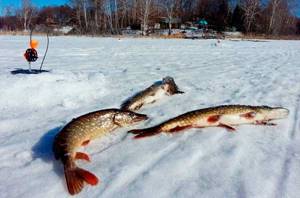
The most difficult thing is to choose the right game with bait that can provoke a passive toothy to attack. Read also: It is better to bait a fallen fish after a pike from the ice of Zherlitsa with small fish, which you will have to lower almost under the very nose of the pike overgrown with leeches. And in order to find the predator’s site, you will have to drill a colossal number of holes and walk more than one kilometer along an ice-bound body of water.
Pike attack on live bait - under-ice video
December
In December the river was frozen, but not forever. Fishing in December is characterized by greater freedom of movement. If at the beginning of the month it is safe to fish in small lakes and ponds, then in the second half, if there have been no long thaws, you can fish in large bodies of water. The fish continues to actively feed, so if you have chosen the right place, your fishing will be successful.
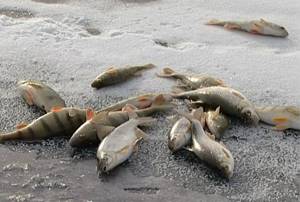
Fishing on the first ice
Gradually, fish from shallow water begin to move to deeper places. The ice is still transparent and loud, so you need to move without much noise. The holes are covered with snow so that the fish under the ice cannot see you. Most of the fish move to wintering pits.
What fishing looks like in December, watch the video:
In December, pike are caught well with live bait, spinners and balancers, and perch with spinners and jigs. The roach has moved away from the shore and is biting well on a jig with bloodworms. You can catch roach with a float rod. In December, fishing is fun: fresh snow, crystal ice, no severe frosts. It's a joy to come back with a good catch.
For pike
Fishing in December for pike is most successful in the first three weeks. The pike does not leave its habitable places, feeding near a school of fry. She grabs the bait greedily. You can catch it using jigging rods and vertical spoons. The pike is still full of strength, so if you are going to shine, you need to choose your tackle accordingly. Long leash, fishing line at least 0.2 mm thick.
The fishing depth depends on the thickness of the ice. If the ice is less than 10 centimeters, then try trolling at a depth of 5–6 meters. If the ice is up to 50 centimeters, then the trolling depth will be 3–5 centimeters. If the ice thickness is more than 50 centimeters, fishing can occur at any depth.
For perch
Fishing for perch in December is a constant search and movement. We need to find a school of perch. And if you find it, don’t yawn, cast your fishing rod as quickly as possible. Slow down a little and that’s it, the perch has gone for another prey. Therefore, the tackle should be such that you can quickly pull the hook out of the perch’s mouth. You will catch small perch with a jig, but with a spinner you have a chance to catch a big perch.
For zander
In December, pike perch also bite well on spoons. They catch it at depth changes and edges. The paths of pike perch do not change, so, knowing their habitats, you can calculate where the school is located.
Roach fishing in January
Roach reacts responsively not only to the onset of deep winter conditions, but also to the slightest change in weather. Its bite directly depends on the amount of oxygen in the water. It is best to look for roach in familiar places with depths of up to four meters - where you have caught it before. If the reservoir is unfamiliar and there is no one to consult about fishing spots, then it is worth walking a little on the ice to look for frozen or fresh holes. Where there will be the most of them, you should try to catch them.
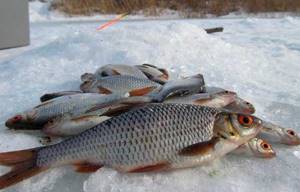
They catch roach using a jig or a float. In both cases, it is better to use bait - purchased or homemade (crackers + coconut flakes + milk powder + flavorings). It would be nice if you add a little live food to the bait - bloodworms, chopped worms, daphnia from aquarium fish food. Read also: About catching roach in January
Dough, bread, mash are used as bait, but still the best bait in January is considered to be bait of animal origin - bloodworms, maggots, worms, all kinds of larvae. If the bite is active, then you can try fishing with a reelless bait, tying a “devil” or “goat” to the line, but even in this case it is better to hook a red bloodworm.
Wonderful quiet day and great bite
Fishing for pike perch in January
It is best to catch fanged fish in January early in the morning or at dawn. You should look for it in holes with snags, among piles, bridge supports, whirlpools, and edges. If your fishing takes place on a reservoir, then it would be ideal to get there during the release of water - at this time, pike perch is excellently caught both with artificial bait and with live bait for several days.
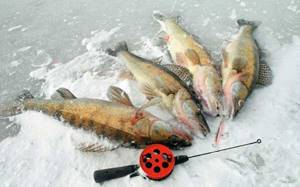
Spinning anglers catch pike perch using narrow elongated spoons with a single hook soldered into the body of the bait, large jigs with sprat or cut fish attached to the hook, as well as small balancers. Less often, pike perch bites on live bait. For this purpose, they use both a float rod with a large float during thaws, and girders. This is interesting: The best balancers for zander
Burbot fishing in January
January is the spawning time for burbot, so fishing is allowed only at the beginning of the month. True, it is during this period that the burbot is most active - its pre-spawning glutton begins, and even the most severe frosts with wind and precipitation will not prevent the predator from having a good lunch.
Burbot is a nocturnal fish, so it is better to catch it after sunset using live bait. At the same time, it is not at all necessary to hook a live fish - it is perfectly caught on offal, pieces of meat, a ball of worms, etc. During the feeding season, you can try to catch burbot using large spoons or a stukalka - a heavy artificial bait similar to an oversized jig. The simplest version of the knocker is made from a lead-filled cartridge case with a single hook soldered into it.
They promise good fishing...
Before packing your backpack and going out for winter fishing, find out the weather forecast, look at what’s going on outside the window and then decide whether to go on the ice.
Winter fishing will be successful if:
- houses and trees standing in the distance are shrouded in a light haze of fog;
- sounds heard in the distance are dull;
- smoke from a burning fire rises smoothly from the chimney;
- there are pink dawns;
- Frost that falls in the morning also portends a good catch;
- it’s cold at night and warm during the day (well, how “warm” can it be in winter);
- mild frosts have settled in calm weather or with a weak western breeze;
- The bite is good on first ice and at the end of winter.
Perch goes in the mornings in clear weather with severe frost; pike perch and rudd can also be caught, but less often. It is good to take bream and rudd on windless days when there is slight frost, and the bite will be from the very early morning hours until late. You can catch burbot in a snowstorm, but for a fisherman in such conditions it is not pleasant to sit on the ice. As frost and snowfall intensify, the bite decreases noticeably, although perch can still be caught.
